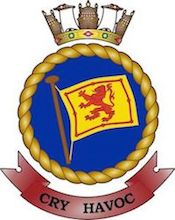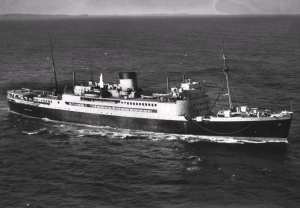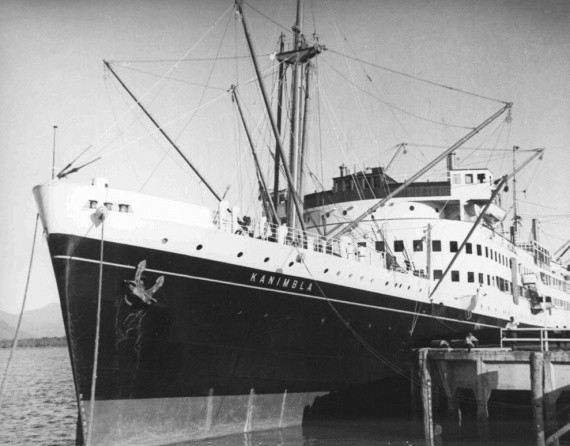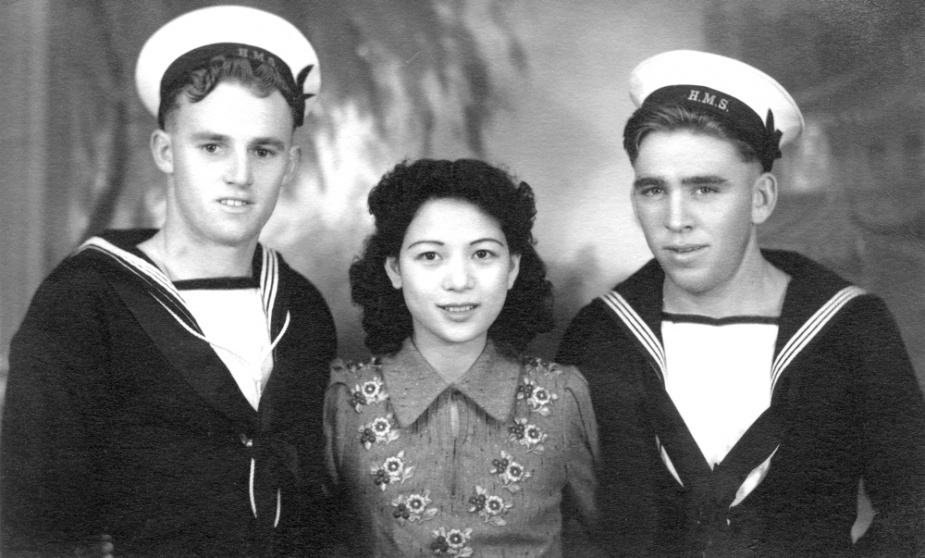HMAS Kanimbla (I)
| Type |
Armed Merchant Cruiser/Landing Ship Infantry |
|---|---|
| Pennant |
F23 |
| Builder |
Harland and Wolff Ltd, Belfast |
| Launched |
15 December 1935 |
| Commissioned |
6 October 1939 |
| Decommissioned |
25 March 1949 |
| Dimensions & Displacement | |
| Displacement | 10,985 tons |
| Length | 468.8 feet |
| Beam | 66.3 feet |
| Draught | 24.4 feet |
| Performance | |
| Speed | 19 knots |
| Complement | |
| Crew | 345 |
| Embarked Forces | 1280 (as LSI) |
| Propulsion | |
| Machinery | Diesel engines, twin screws |
| Horsepower | 10,000 |
| Armament | |
| Guns |
|
| Awards | |
| Battle Honours | |

The twin screw motor vessel Kanimbla was built for McIlwraith McEachern Limited and from May 1936 until September 1939 she operated a passenger service between Cairns and Fremantle. Upon the outbreak of war she was requisitioned on 5 September 1939 and converted to an Armed Merchant Cruiser at Sydney. She commissioned into the Royal Navy as HMS Kanimbla on 6 October 1939.
Armed Merchant Cruisers were employed in long ocean patrols for enemy raiders and blockade runners, supplementing built for purpose cruisers and allowing them to be released for the more arduous fleet duties.
Under the command of Commander Frank Getting RAN, and with a complement drawn almost entirely from the Royal Australian Navy, she departed Sydney on 13 December 1939 for Hong Kong.
The first half of 1940 was spent patrolling off the Chinese and Japanese coasts in the course of which she intercepted and took in charge the Russian vessel V Mayakovsky, known to be carrying contraband. This ship was boarded and searched and, suspicious cargo being found, was eventually handed over to a French cruiser to be escorted to Saigon for investigation.
As European countries were occupied by Germany, Kanimbla was involved in attempting to ensure that their ships in the Far East came under Allied control. To this end she boarded ten Norwegian and a Danish ship off the mouth of the Yangtse River during April 1940 and sent them to Hong Kong. In June 1940 she was detached to Singapore and en route visited Saigon in an unsuccessful attempt to convince the French warships there to join the Free French forces.
After moving to the Singapore area Kanimbla undertook patrol and escort duties around Malaya and the East Indies, eventually extending out into the Indian Ocean. On 25 March 1941 Getting, now promoted to Captain, was relieved by Captain WLG Adams RN.
On the night of 24 August 1941 Kanimbla, with 300 Indian troops embarked, led a heterogeneous flotilla in a surprise attack on the Iranian port of Bandar Shahpur, capturing eight German and Italian merchant vessels with valuable cargoes, two Iranian gunboats and a floating dock. Kanimbla went alongside the burning Italian tanker Bronte and fought the fires while engaging a train with her main armament and aircraft with her 3-inch guns. She remained in the area until 11 October, supervising the port and carrying out salvage work on the captured vessels, including a major effort on the German freighter Hohenfels for which Petty Officer (Diver) John Humphreys was awarded a George Medal for his work in the ships flooded engine room shutting off bilge suction valves.
After further work in Indian waters during the latter part of October and November, Kanimbla proceeded to Singapore and escorted the first convoy out of that city after the Japanese attack on Malaya. She arrived in Port Melbourne on Christmas Day. She carried out further convoy work off the Australian coast and in the Indian and Pacific Oceans. Captain Adams was relieved by Acting Commander Frederick James, RAN on 2 February 1943. On 2 April Kanimbla arrived in Sydney to be converted to a Landing Ship Infantry (LSI) for operations in the Pacific.
The conversion involved the removal of her 6-inch guns and the augmentation of her anti-aircraft armament by the addition of a 4-inch gun and 2-pounder and 20mm close range weapons. Radar was also added. She was fitted to carry 16 to 24 landing craft, which were raised and lowered by davits fitted to either side of her superstructure. Scrambling nets were fitted to enable troops to quickly enter the landing craft after they had been lowered. The ship's interior wood paneling was replaced by steel sheets and all available space was converted for the carriage of 1280 troops although more were carried on occasion. On 1 June 1943 she recommissioned as HMAS Kanimbla. On 30 July Commander James was relieved by Commander Norman Shaw RAN.
Kanimbla departed Sydney for Brisbane on 22 October 1943 and remained in that area until January 1944 when she undertook a voyage to New Guinea. The next month she was involved in exercises in Trinity Bay, near Cairns. After proceeding again to New Guinea she carried out exercises with elements of the United States 24th Infantry Division at Goodenough Island in early April in preparation for the landings at Hollandia. On 22 April, in company with HMAS Manoora, five other transports, 16 Landing Craft Infantry and seven Landing Ships Tank, Kanimbla landed her troops at Tanahmerah Bay without incident.
Subsequent to this operation Kanimbla was involved in training and transport duties in New Guinea waters. Commander Shaw was temporarily relieved by Lieutenant Commander Stanley Crawford, RANR(S) on 18 June until the arrival of Commander Andrew Bunyan, RANR(S) on 10 August.
Arriving at Aitape on 1 September, Kanimbla began preparations for the Morotai landings and on 9 September embarked 1215 officers and men. On 10 September, with 36 other landing ships and supporting vessels of the White Beach Attack Group, she departed for Morotai. The landings took place on 15 September with little opposition and few casualties to Allied forces. On 16 September, in company with Manoora, Kanimbla departed for Humboldt Bay, arriving on 18 September.
At Humboldt Bay, in company with Manoora and Westralia, Kanimbla overhauled equipment and embarked troops and supplies for the landings on Leyte. A full scale rehearsal was carried out at Tanahmerah Bay on 10 October. On 13 October the three Australian LSIs departed for Leyte as part of a large assault convoy escorted by a covering force of American and Australian cruisers and destroyers. The Australian landing ships were part of the Panaon Attack Group which detached from the main group at 2:00am on the morning of 20 October and arrived off Panaon at 8:45am. Again no Japanese resistance was encountered. Cargo was discharged by 4:00pm and the ships sailed for Humboldt Bay arriving on 25 October.
Kanimbla returned to Leyte on 14 November, transporting troops as part of a 26 ship convoy. On 30 November she arrived at Torokina and, with Manoora and Westralia and 15 other ships of Landing Group 'A', commenced embarking 1,320 troops and stores for the Lingayen landings. Kanimbla and the rest of Landing Group 'A' then proceeded to Lae where, in company with Landing Group 'B', practice landings were carried out. The ships then sailed for Manus. On 31 December they departed Manus to execute Assault Mike I on Luzon Island in Lingayen Gulf.
As part of Task Force 79, the Lingayen Attack Force, Kanimbla passed through Surigao Strait and proceeded up the western side of the Philippine Archipelago to Lingayen Gulf, arriving on 8 January 1945. As the ships made their final approach to the gulf they came under air attack, Kanimbla being near missed by a Zero fighter bomber which was shot down. The troops were landed on the 9th, supported by a heavy bombardment. Kanimbla and her consorts discharged their cargoes rapidly and left the area that evening to avoid further air attack, returning via Leyte to Morotai. After further transport duties in the New Guinea area Kanimbla was back in Sydney on 7 March after an absence of nearly 17 months.
Kanimbla' s next operation was the invasion of Brunei. Departing from Morotai on 4 June, again in company with Manoora and Westralia and a large group of American vessels, mostly landing ships and landing craft, she arrived off Brunei on 10 June. She commenced landing her troops on Green Beach just before 9:00am with little or no opposition. She unloaded her cargo that day and set sail for Morotai on 11 June, arriving on 14 June.
The final amphibious landing of the Pacific War was at Balikpapan and Kanimbla and her two sister LSIs took part. On 25 June at Morotai, she completed the embarkation of 1267 officers and men, mostly from the 2/9 Battalion, as well as 361 tons of cargo. She sailed for Balikpapan the next day, arriving on 1 July. That day was spent disembarking her troops and unloading the cargo and she sailed for Morotai at 7:30pm. She arrived on 4 July, embarked reinforcements and departed the same day, returning to Balikpapan on 7 July. She sailed the next day and spent the remainder of the war on transport duties around New Guinea, the Philippines and Borneo.
After the cessation of hostilities Kanimbla was engaged in repatriating Australian servicemen from the Pacific Islands and returning Dutch dependents to the East Indies. Commander Crawford again became her Commanding Officer from 6 September 1945 until 18 January 1948 when he was relieved by Captain Alan Cousin RANR(S), who remained in command until she was decommissioned.
Between October 1946 and June 1948 she made a number of voyages between Sydney and Japan transporting members of the British Commonwealth Occupation Forces. In December 1947 Kanimbla transported the first group of European post-war refugees to arrive in Australia from Fremantle to Melbourne, and in 1948 took personnel and stores to the United Kingdom to commission HMAS Sydney, returning with British personnel who had enlisted in the Royal Australian Navy as well as 432 displaced persons.
After one more voyage to Japan she was decommissioned in Sydney on 25 March 1949 and, after refitting, returned to her owners on 13 December 1950. In 1961 she was sold to the Pacific Transport Company and renamed Oriental Queen. Chartered by the Indonesian Government, she was employed for three years transporting pilgrims from Indonesia to Jeddah.
She was later chartered and then purchased outright by a Japanese shipping company for service between Guam and Yokohama. She completed her final voyage in 1973 and was shortly thereafter sold for scrap and broken up in Taiwan.
Further reading
- 'Cry Havoc! HMS-HMAS Kanimbla goes to war' by Peter Sherman - published by PS Sherman, Glen Waverley, 1993.













